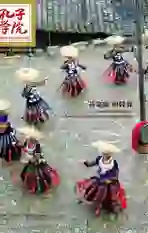学成语俗语 话贵州今昔
2023-11-18崔玉华
崔玉华



汉语中有两个广为人知的成语:“夜郎自大”和“黔驴技穷”。这里的“夜郎”和“黔”指的都是中国西南的一个省份——贵州。
夜郎自大
汉朝初期,西南的夜郎国(今贵州西部)占地此较大,国王以为他的国家全天下最大。他见到汉武帝派来的使臣便问:“汉朝和夜郎哪个大?”这个典故被著名史学家司马迁记入《史记》,“夜郎”从此家喻户晓,成了“不自量力,妄自尊大”的代名词。人们嘲笑夜郎作为偏居一隅的小国,是井底之蛙。
但根据考证,夜郎国作为中国西南地区第一个由少数民族建立的国家,史籍记载的历史就有300多年,领土涉及今天的云南、贵州等地。夜郎人善于进行对外贸易,国家和百姓算得上富庶,其实力不容小觑。
现在的贵州早已不似夜郎国时那样闭塞,四通八达的水陆交通网已经使贵州成为中国西南地区的交通枢纽,成为长江经济带的重要组成部分。十多个国内和国际机场把贵州和全国乃至世界相连。贵州在电讯领域已经成为全国的“领头羊”,贵州的科研工作者跨越葬莽群山,利用“中国天眼”展望世界,甚至探索宇宙的奥秘。
黔驴技穷
“黔驴技穷”的典故出自唐朝文学家柳宗元的《三戒·黔之驴》。故事讲的是,一头毛驴被带到黔地(今贵州),放到山脚吃草。山上的老虎发现了这个从没有见过的怪物,开始只是远远观望,然后慢慢靠近试探,最后发现毛驴除了大叫或尥蹶子没有其他本事,于是就把驴子吃掉了。人们用这个成语指“仅有的一点本领都用完,已无计可施”之意。现在,我们迁是聊聊贵州省的简称为什么是“黔”吧!
在汉语中,“黔”是一个形声字,形旁“黑”指“黑色头巾”,声旁“今”意为“当面的”,“黔”表示“带黑头巾出门见人”。东汉著名文字学家许慎在《说文解字》中解释:“黔,黎也。秦谓民为黔首,同谓之黎民。”就是说,秦朝把老百姓称为“黔首”或“黎民”。秦王朝一统天下,在贵州设立黔中部,不仅要从行政上控制此地,更要从思想上让南方的山民意识到自己是秦国的百姓。后世延续了这个称呼,“黔”字就成了贵州的代称。
虽然贵州省群山环抱,有些地方经济相对落后,但贵州人并不保守。以人口占比最大的苗族为例,他们佩戴的头饰多是纯银打造,高调张扬。他们的服饰色彩艳丽,织、绣、挑、染工艺繁复,服饰图案更具有丰富的文化内涵,有表意和识别族类、支系及语言的重要作用。
贵州地处中国西南,境内多高原、山地和丘陵,索有“八山一水一分田”之说,是中国平原极少的省份。但贵州并不贫瘠,除了神奇的自然景观、浓郁的民族风情等旅游资源吸引着国内外游人,其独特的地形地貌和气候更孕育了丰富的野生动植物资源。贵州是全国四大中药材产區之一,有药用植物资源4 000多种,占全国中草药品种的80%,故有“夜郎无闲草,黔地多良药”的说法。
朋友们,来贵州吧!感受黔地的无限风情,领略“夜郎”的巨大变化!
A Story of Guizhou Past and Present Reflected in Idioms
There are two widely used idioms in Chinese:yelang-zida (as conceited as Yelang)and qianlv-jiqiong (at one’s wit’s endlike a newly-arrived donkey in Qian).Here both yelang and qian refer to asouthwestern province in China,the Guizhou Province.
yelang-zida
In the early Han Dynasty, the Kingdom ofYelang in the southwestern region of China (thewest part of today’s Guizhou Province) controlleda large territory, so that the king believed his kingdomthe largest in the world. He asked the ambassadorsent by Emperor Wu of the Han Dynasty:“Han and Yelang, which is the larger kingdom?”This story was recorded in the Records of History bythe renowned historian Sima Qian, and since then“Yelang” has become a household epithet for thosewho “do not know their own capacities and are ridiculouslyconceited”. As a relatively small kingdomlying in the remote corner of the continent, Yelangis mocked for its distorted sense of self-importance.
However, according to historical research, as the first kingdom established by ethnic minorities in southwestern China, Yelang had a recordedhistory of over three hundred years and possesseda territory covering today’s Yunnan and Guizhouprovinces. Yelang people were good at tradingwith other regions and the kingdom and its peopleenjoyed considerable affluence. Therefore, Yelangas a kingdom was not at all a small power.
Today’s Guizhou Province is no longer geographicallyisolated as Yelang. Now, the wellconnectedwater and land transportation networkhas made Guizhou the transportation hub of southwestChina and an important part of the YangtzeRiver Economic Belt. Over a dozen domestic andinternational airports connect Guizhou to the otherparts of China and the world. Guizhou also ranksamong the top players in the eld of telecommunicationsin China. Scientistc researchers in Guizhouare using “China’s Tianyan”, the Five-hundred-meterAperture Spherical radio Telescope (FAST) to lookacross the mountains in Guizhou into the worldand to explore the mysteries of the cosmos.
qianlv-jiqiong
The idiom qianlv-jiqiong originates from thestory “A Donkey Comes to Qian” collected inthe Tang-dynasty writer Liu Zongyuan’s ThreeParables. In this story, a donkey was brought tothe area of Qian (today’s Guizhou). While it wasgrazing at the foot of a hill, a tiger from the hilldiscovered it. Never having seen such a strangelookinganimal, the tiger initially only dared to observeit from afar. When the tiger had come closerto the donkey step by step, it realized that the donkey’stricks were no more than braying and kicking.then the tiger ate the donkey. Today, people use theidiom to describe a situation where one has exhaustedone’s abilities and can do nothing more. Now let’slook at how “Qian” has become a synonym for theGuizhou Province!
In Chinese, 黔 is a “shape-and-sound” character,or a pictophonetic character. The semanticelement means “black headscarf ”, while the phoneticelement means “face to face”. So together黔 means “going out to meet people with a blackheadscarf on”. The famous philologist Xu Shenfrom the Eastern Han Dynasty explains thus in hisdictionary Shuowen Jiezi: “Qian means the mass.The Qin Dynasty rulers called people qianshou,or ‘the black-headscarfed’, which is another way tosay limin, ‘the common people’.” In other words, theQin Dynasty rulers called their subjects qianshouor limin. A er the rst emperor of Qin had uni edChina, he set up the Qianzhong county in today’sGuizhou, not only to control this regionadministratively, but also to inculcate in themind of these southern mountainous people asense of being the subjects of the Qin empire. The epithet was passed down to later generations and“Qian” since then has become the synonym forGuizhou.
Enclosed by mountains, some places inGuizhou are relatively economically less developed,yet Guizhou people are by no meansconservative. For example, the Miao people, thelargest population group in Guizhou, love to wearflamboyant ornamental headgears made of puresilver. Their ethnic clothing features daring colorsand elaborate weaving, embroidery, lining anddyeing techniques. The patterns on these clothesalso contain rich cultural meanings and functionas elaborate signs to convey meaning or to identifyone’s ethnic groups, subgroups and languages.
Guizhou is located in the southwest of Chinaand a great proportion of it consists of plateaus,mountains and hills, therefore there is the saying“for each arable land there are one river and eightmountains” to describe the scarcity of flatlandsin Guizhou. Yet Guizhou is far from a land ofscarcity. Its breathtaking natural landscape andcolorful ethnic culture attract tourists from homeand abroad. Moreover, its unique topographicalfeatures and climate cultivate a wealth of wildliferesources Guizhou is one of the four majorChinese herbal medicine production areas and ishome to over four thousand types of plants usedfor medicine, accounting for 80% of the medicinalherbs produced in China. Therefore, it is said that“there is no idle grass in Yelang, and many goodmedicines can be found in Qian”.
Welcome to Guizhou to have a taste of thepoignant local culture and witness the great changesof “Yelang”!
